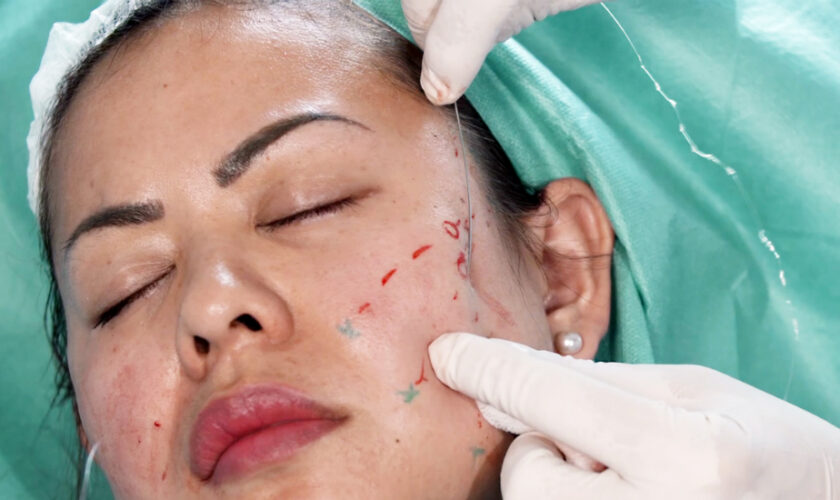A thread lift is a minimally invasive cosmetic procedure that involves using fine threads to lift and tighten the skin. The threads are typically made of absorbable materials, such as polydioxanone or polylactic acid, which dissolve over time.
The procedure can be used to treat sagging skin on the face (if you need a facelift), neck, or other areas of the body. Thread lifts can be performed using local anesthesia and require no recovery time. Results typically last for about 1 to 3 years before the threads dissolve and the skin returns to its pre-procedure state.
Pros and Cons of the Procedure
Thread lifts offer a number of advantages over traditional surgical facelifts. This best explains why they have been exponentially growing in popularity. Most people choose thread lift in Singapore over related treatments because;
- They are less expensive: Thread lifts are less expensive because they are a minimally invasive procedure. Unlike traditional surgery, where you have to pay for hospitalization, anesthesia, and other related costs, you only have to pay for the procedure itself.
- They are less invasive: Thread lifts are less invasive than traditional surgery, meaning that they cause less scarring and bruising. In addition, they can be performed using local anesthesia, which means that you will be awake during the procedure.
- You can get back to your life immediately: Unlike traditional surgery, which requires a lengthy recovery time, you can get back to your life immediately after a thread lift. This is because there is no cutting or stitches involved.
Now, while thread lift has several advantages, there are also some disadvantages. Here are some of the disadvantages of thread lifts that you should know before consenting to the procedure:
- The results are not permanent: The results of a thread lift typically last for an average of two years before the threads dissolve. This means that you will need touchup treatments if you want the effects to last a little longer.
- They are not as effective as traditional surgery: Thread lifts are not as effective as traditional surgery in terms of providing long-term results. If you are looking for a more lasting solution, you may want to consider traditional surgery.
- The treatment can still fail: The treatment can fail if the threads are not inserted correctly or if they do not dissolve properly. They may also not bring out the desired results if you are not a good candidate for thread lifts. That said, to get the best out of your thread lift in Singapore, take time to find a board-certified plastic surgeon with a good reputation.
Overall, thread lifts are a safe and effective procedure that offers a number of advantages over traditional surgery. A good plastic surgeon will help you understand all that you need to know about thread lifts before you consent to the treatment.
When to Consider Getting a Thread Lift
As you have seen above, thread lifts actually work. The big question thus could be; when should you really consider getting a thread lift?
There are numerous factors that you will have to put into perspective before scheduling for a thread lift in Singapore. Some people might need surgery because they were born with certain physical traits, while others may have developed them due to the natural aging process. The following are some key points to ponder when thinking of going in for a thread lift:
- Your age: Thread lifts are typically performed on people in their late thirties or early fifties. If you are younger, you may want to consider other options, such as injectables or fillers, which can provide similar results.
- If you have realistic expectations: It is important to have realistic expectations about what a thread lift can do for you. A thread lift will not make you look like you did when you were in your twenties. However, it can help improve the appearance of moderate to severe facial sagging.
- If you are bothered by moderate to severe facial sagging: If you are bothered by moderate to severe facial sagging, a thread lift in Singapore may be the right solution for you. Remember that the results of a thread lift are not permanent, so you will need to be prepared for this.
- If traditional surgery is not an option: If you have health concerns that make traditional surgery a risky proposition, a thread lift may be a good alternative. In addition, if you do not have the time or money for traditional surgery, a thread lift can provide similar results at a fraction of the cost.
- If you have enough loose skin: If you have enough loose skin to warrant a thread lift procedure, a thread lift may be the right solution for you. Thread lifts are not as effective as traditional surgery in terms of providing long-term results, but they can provide a significant improvement in the appearance of your face.
Overall, if you are considering a thread lift, it is important to consult with a plastic surgeon to see if you are a good candidate for the procedure. The plastic surgeon should be board-certified, have experience performing thread lifts, and be able to answer any questions you may have about the procedure. This way, you can be sure that you are making the best decision for your needs.
Risks Associated with the Surgery
As with any surgery, there are risks associated with a thread lift. The risks will vary depending on the type of procedure you have, the experience of your surgeon, and your overall health.
The most common risks associated with a thread lift include bleeding on the injection site, which is usually mild and can be controlled with pressure, bruising, and swelling. These side effects are usually temporary and will resolve within a few days to weeks.
In rare cases, more serious complications can occur, such as contour irregularity, nerve damage or paralysis, and thread extrusion. These complications are usually the result of a surgeon who is not experienced in performing a thread lift. That said, if you are considering a thread lift, always insist on working with a plastic surgeon with proven experience in performing the procedure.
Final Words
Thread lifts actually work, but the emphasis should be on finding a skilled, board-certified plastic surgeon. Experienced surgeons increase safety, but there are always risks associated with surgery, no matter who does it. If someone is bothered by moderate to severe facial sagging, a thread lift may be the right solution for them, providing long-term results, albeit less so than traditional surgery.
At the Artisan Clinic, our team of professionals are experts in thread lifts and can provide you with the best possible care. Contact us today to schedule a consultation. Call: +6598187887.
The Artisan Clinic@Wisma
435 Orchard Rd, #20-03 Wisma Atria Office Tower, Singapore 238877
+65 8879 7887



